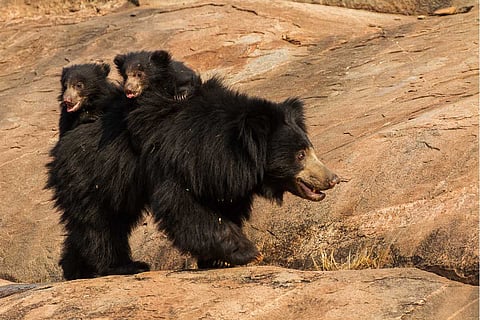

The UNESCO World Heritage site of Hampi is well-known for its archaeological wonders but if you want to take a break from the monument-hopping, you can do a wildlife safari in the Daroji Sloth Bear Sanctuary. Besides being Karnataka’s only sloth bear (Melursus ursinus) sanctuary, it is also claimed to be Asia’s first. Sprawling rock-strewn hillocks interspersed by scrub jungle, the sanctuary shelters some bewildering wildlife and an amazing collection of rare and endangered Deccan flora.
What makes the wildlife safari in Daroji distinctive from other reserves is that there are no trails to explore here but only a single 8-km path leading to a viewing deck. The meandering walkway to the watchtower, located over a small rocky hill, is well laid out. The viewing deck is open for a few hours every day.
Armed with a pair of binoculars, we waited with bated breath for the sloth bears – said to be shy animals – to arrive for feeding time. We saw the forest guards pour watered jaggery in certain areas to attract the bears. From our perch in the viewing area, we had a glimpse of the bears descending from the opposite hillock, called Karadikallu Gudda. It was a delight to watch them ambling around rummaging for food in crevices. We recognised their shaggy black coat, distinctive long muzzle, protruding lip, and a distinct white V-shaped patch on their chests. They lumbered towards the rocks where ‘sweet licks’ have been placed and slurped up the jaggery placed on the rocks. We could see them scurry boulder to boulder and became completely engrossed in licking the jaggery off the surfaces.

A worker prepares a jaggery meal for the bears. Pic: Susheela Nair

Mother bear and her cubs scout for 'sweet licks'. Pic: Devendra Kumar S
Two of them snarled at each other ready for a confrontation. Two cubs wobbled behind the adults while two other cubs took a piggyback ride on their mother’s back. We sighted one of them leaning against a boulder. It is said that these bears have a particular proclivity to ‘vacuum’ up termites and ants using their long snouts. They have an impeccable sense of smell but limited long-range vision and are easily startled. In areas where the forest cover is sparse and daytime temperatures high, they are nocturnal and take shelter in rock outcrops, thickets, and tree cavities to escape the heat.

Bears snarl at each other. Pic: Devendra Kumar S

The viewing deck at the sanctuary. Pic: Susheela Nair
In 1994, the Government of Karnataka declared over 55.87 sq km of Bilikallu Reserve Forest as the Daroji Sloth Bear Sanctuary. Following this, through sustained efforts the Forest Department transformed the forest, which had nothing but barren hillocks and thorny trees, into a verdant land with many local species of flora and fauna. Wild fruit-bearing trees were grown and waterholes created to prevent animals from straying into neighbouring villages in search of food. Honey and termites, which bears are fond of, were also made available here in plenty.

A peacock at the Daroji Sanctuary. Pic: Devendra Kumar S
Locals believe that the name Daroji comes from the word darwaze or gates, indicating that this was once a gateway to the nearby Hampi. Today there are no gates to be seen, only boulders strewn around.
There are myriad species of animals and birds to be identified in the sanctuary. If you are lucky, you might spot wild boar, pangolin, porcupine, jackal, striped hyena, monitor lizard, and leopard. The wolf, jungle cat, civet cat, fox, and common mongoose can also be seen in the sanctuary. Black-naped hares are ubiquitous and easily seen scurrying across the forest paths. Among birds, you can spot yellow-throated bulbul, a rare sight in the rocky shrub jungles. We also sighted a peacock and grey francolin during our safari. The sanctuary also shelters 27 species of butterflies, including the common blue bottle, cabbage whit, crimson tip, common emigrant, common grass yellow, grass jewel, pioneer, sailor, and others. Among Daroji’s reptiles are the starred tortoise, rock gecko, and the termite hill gecko.

A grey francolin at the Daroji sanctuary. Pic: Devendra Kumar S


> Sanctuary timings are from 6 am to 6 pm. It is best to visit during feeding times when the bears tend to venture out of their caves.
> August to April is best for wildlife viewing.
Susheela Nair is an independent food, travel and lifestyle writer and photographer contributing articles, content and images to several national publications besides organising seminars and photo exhibitions. Her writings span a wide spectrum which also includes travel portals and guide books, brochures and coffee table books.